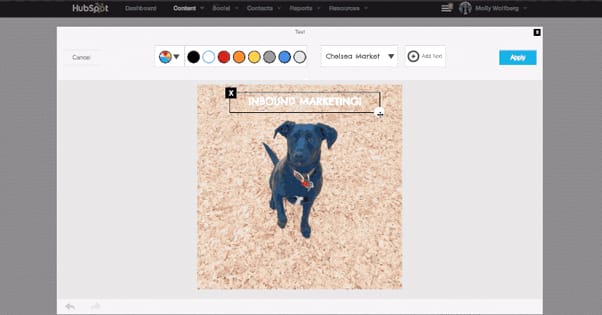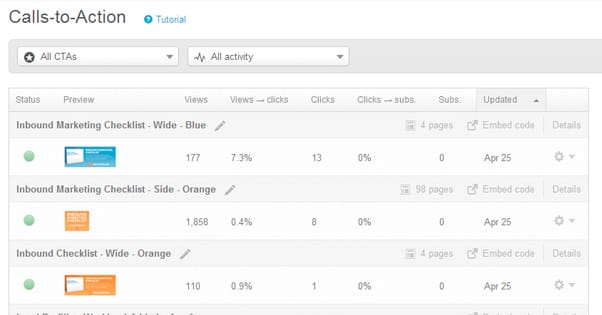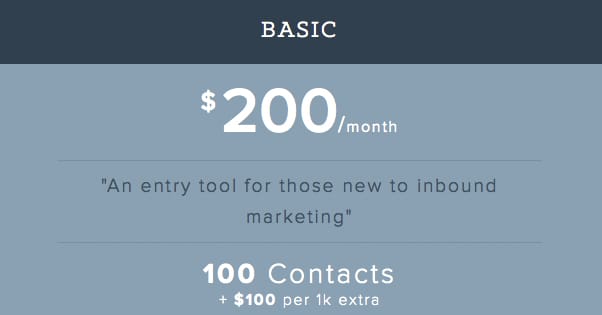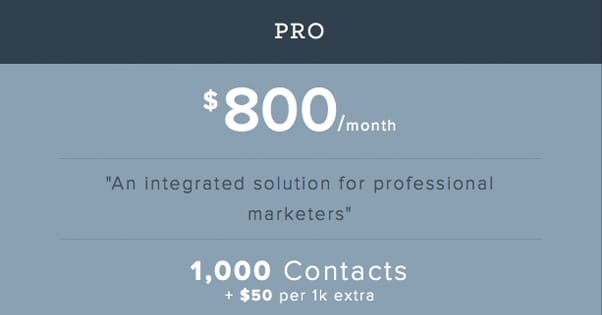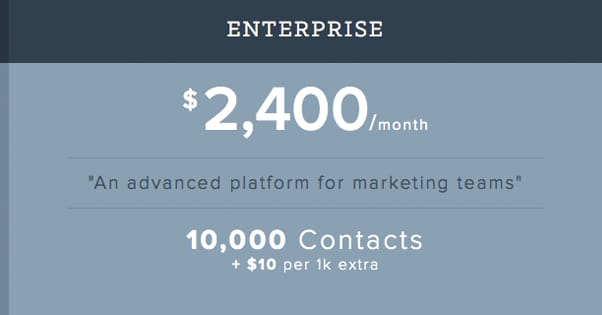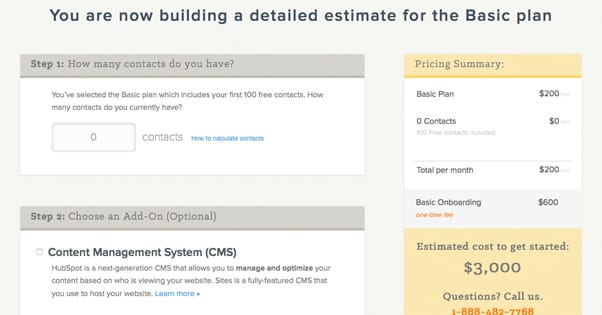Our Review of Hubspot’s Blog Marketing Tools
Published by Kenny Novak • Content Marketing • Posted July 7, 2015 ContentPowered.com
ContentPowered.com
Hubspot has two things going for it; a high quality marketing blog, and an all-in-one blogging platform. I’m not here to review the blog, so you can guess that I’m here to review the software. First, though, let’s look at the features.
Hubspot Features
First of all, Hubspot is a blogging platform. If you’re used to WordPress, for example, you’ll be right at home. You have the same sort of text box window with formatting options, publishing options, and everything else you’ve come to expect from a blog interface. Of course, that’s all pretty obvious. If Hubspot didn’t even do blogging as well as vanilla WordPress, we could end this review right here.
When you go to create a new blog post, you can create a blank post or you can use one of their “blueprints.” These are sort of like templates, only they’re very basic. For example, you have a “list post” blueprint, and a “how to” blueprint, and a “visual post” blueprint. Basically, all these do is guide you through the process of making that kind of post without making novice mistakes, like multiple H1 tags in list subheadings, or off-position and poor quality images.
Speaking of images, Hubspot also has a built-in image editor to help you crop, resize, and add text and effects to images for your posts. It’s a bit more robust than Microsoft Paint, but it’s not as useful as Photoshop. I tend to compare it to many of the mid-range image editors available for phones; full of basic functionality and a few more advanced features, but not suitable for heavy duty editing.
Hubspot has SEO functionality right off the bat. WordPress and other blog platforms require plugins to give you all the various forms, fields, analysis options and research necessary to run SEO properly. Hubspot even has a sort of “active analysis” or as-you-type scan that gives you SEO suggestions in real time. That is, assuming you write your posts directly in the interface. If you’re writing in Google Docs or MS Word and you paste your content in, you’ll see all the suggestions at once.
There are three basic pillars of SEO Hubspot optimizes for. Search, Social, and Mobile. Mobile is interesting, in that it gives you a preview of what your posts will look like to mobile users. Use this to make sure you’re not writing headlines that wrap around five times, or images that look muddy and terrible. Social optimization is basic; it just allows you to choose which social sharing buttons appear on your posts. Search, of course, has the keyword analysis and meta data you’ve come to expect.
Another feature they boast about on their landing page is an optimized CTA system. With as many businesses and as much data as Hubspot has at its disposal, they’ve refined the art of the CTA button and give you some very robust bases from which to work. You can then test and optimize them for your site and audience.
Of course, no CTA program would be complete without lead tracking, and Hubspot has that in spades. They create individual profiles for individual users, showing when they first encountered your marketing and through what channel, when they most recently engaged with your brand, and what stage of the sales lifecycle they’re in. This comes with a timeline as well, showing changes over time. It’s actually a ton of data, and if you’re not used to this sort of detailed analytics, it can kind of blow your mind. Even I had to pause a second and marvel at just how much data can be harvested from just landing pages, emails, and social shares.
Hubspot also strives to make itself a central pillar in your marketing, which means they have all the tools necessary to manage your emails and newsletters. Think MailChimp, only integrated into the one central platform rather than using another application for one purpose.
With the email management comes subscription management with a few simple buttons. You can choose to send out instant notifications upon publication of a post, or set that post to be included in daily, weekly, or monthly roundups instead. Particularly important posts might show up in all of them.
No blogging platform would be complete without content management options, and Hubspot has those in spades. They have a robust content calendar akin to WordPress’s Editorial Calendar plugin. The only difference is that it has some more advanced color and symbol coding for posts, as well as filters to see your calendar for specific types of media, like newsletters and social shares.
If you’re a business running a team for your marketing and blogging presence, their content management system has task assignment as well. This lets you hand off blog posts, social projects and other tasks to individual team members, with their progress reflected in the content calendar.
Analytics, now, you had to know they would exist. If you’re familiar with Facebook Insights, you’ll see some similarities in Hubspot analytics. In particular, the layout of traffic graphs and per-post breakdowns is familiar to users of both Insights and Google Analytics.
My primary gripe with their analytics is that the most advanced analytics, showing charts of specific groups of your audience and their relations with different parts of your marketing campaigns, are all locked behind the Enterprise edition of the platform. That leads me to the next section:
Hubspot Pricing
Hubspot has three different tiers of plan, but you can customize them all. This means you can customize and scale your access to their tools depending on the needs of your business. All plans have a 30-day free trial, beforehand. The free trial is a full version of the Professional level service.
Basic
The lowest level is appropriately named Basic, and it begins at $200 per month, billed annually. That’s a hefy price tag; $2,400 in one lump bill is absolutely nothing to sneeze at. What do you get with Basic? You can look at a chart here, but I’ll summarize it for you.
- Management of 100 contacts free, with a charge of $100 for an additional 1,000, as many as you need.
- A limit of 3 users of the software, so limited to small teams.
- Up to 3,000 site visits per month. This firmly limits the Basic plan to small websites and businesses.
- 1 allowed subdomain.
- Up to 1,000 sent emails per month.
- All of the blogging features, including SEO recommendations, analytics, social publishing and mobile optimization.
- All of the social media features, including social monitoring, analytics, and a bookmarklet.
- SEO features, which include link and keyword optimizations.
- Basic CTAs.
- Landing pages with forms, mobile optimization, and smart fields.
- Basic lead management with segmentation, and little else.
- Almost all of their email marketing features, including an optimizer, list building features, and email testing.
- The editorial calendar, of course.
- Basic analytics, with goal tracking, campaign management, personas, sources, and competitor analysis. Landing page analysis is also included.
- Marketplace access for templates and services.
- Mobile integration with contacts, reports, publishing and monitoring.
- Access to Hubspot Academy, with training, certifications, user groups and a marketing library.
Professional
If you choose to upgrade from Basic to Professional, you’re making a significant jump in price. At $800 monthly, you’re looking at an annual bill of $9,600. For this heft price, you get everything listed above, plus:
- A higher contact limit of 1,000, with the ability to expand it by 1,000 for $50 per thousand.
- Unlimited users for teams.
- Unlimited site visits.
- Up to 4 subdomains.
- An email send limit of 10x your contacts limit, which scales depending on how much extra you pay.
- Smart CTAs in addition to normal CTA features.
- Smart content and progressive profiling for landing pages.
- Salesforce integration, lead scoring, and notifications for lead revisits.
- Marketing automation tools, including email nurturing, sales notifications, and automation recipes akin to IFTTT.
- More analytics, including list analytics, prospect reporting and attribution reports.
- User roles, access to the Hubspot API, and webhooks for team utilization.
Enterprise
As you might expect, the Enterprise tier is even more expensive, with an initial price tag of $2,400 per month. For that lump sum of $28,800, you get all of the Pro level stuff, plus:
- The contact limit raised to 10,000, with $10 per thousand to expand it.
- Unlimited subdomains.
- Split testing for CTAs, landing pages, and emails.
- Event based triggers for automation.
- Revenue reporting, custom contact reports and companies reports.
As if that wasn’t enough, there’s also a lot of additional add-ons for all three packages you can pay for. You can have a dedicated IP address, a transactional email address, a CMS, and more. These cost more, like $500 per month for the IP address.
One thing to note is that the price tag is even steeper regardless of which package you choose, at least for your initial payment. All three tiers require onboarding, which is their specific program of training to use their tool to the fullest. For the basic tier it costs $600, the Pro tier costs $3,000, and the Enterprise tier costs $5,000.
So, all things considered, you get a ton of features. On the other hand, you’re paying out the nose to get them all in one place. You can cut your price tag by a huge amount by using IFTTT for some automation, WordPress and some plugins for most of the CMS features and blogging tools, Google Analytics and some third party analytics tools and tracking for most of those needs, and something like Mailchimp or Aweber for your email management.
You’re paying a premium for two things with Hubspot; to have all of these tools in one place under one interface, and to have the support and training Hubspot gives you.
Impressions and Thoughts
Enough with the features list; if you want to be sold Hubspot, you can go to their landing pages. I just bring up the features list to show you just how much you get, and just how much you’ll be paying. It kind of puts everything into scale.
First off, right off the bat I can tell you that a small business is probably not going to be able to afford to implement Hubspot. Their up-front, non-negotiable annual billing is pretty intense, and that’s a huge hit to a business that’s probably operating on a tight margin. You may be able to squeeze out the value you need to make the money back within the first year, but it all depends on how well you take to the platform and how much well you can grow your audience.
On first impressions, Hubspot is pretty potent. They have a guided experience to start you with, a process flow to get you through any particular task you want to do. For veteran bloggers and marketers, it’s actually almost frustrating, and is designed for people who may not know the ins and outs of blogging and blog marketing.
One gripe that I have, and that I’ve seen shared on other sites, is the limited accuracy for some data Hubspot uses to give you suggestions and guidance. For example, they use data from Google’s keyword tool, but they don’t give you much chance to customize it like you can if you do it directly through Google. They also give you an estimate of how hard it is to rank for a given keyword, but don’t really explain where they derive the numbers.
It all strikes me as somewhat newbie-centric, which is interesting given the very not newbie-friendly price tag. If you’re paying this much for a professional-level tool, you should know the basics of how to use it, and a few of the choices Hubspot makes are almost patronizing when you dig into them a bit.
As for the actual blogging tools themselves, they’re also surprisingly basic. If you’re used to a tricked-out WordPress installation with a few customization plugins, you’ll be surprised at how little Hubspot actually has. You have your basic text and image editors, but you’re limited in the amount of customization you can implement on your posts.
I will say, though, that the CTA functions are very nice. If there’s one thing Hubspot does well, it’s CTAs. Of course, seeing behind the curtain, so to speak, gives you the insight into other marketers to see exactly who is using the feature in Hubspot and who has a custom solution. Hubspot CTAs are generally formulaic, but that’s because they work.
The page grader is a good tool, at least. It gives you some insight into which pages on your site are doing the best and are most valuable, both from a traffic standpoint and from a conversions and revenue standpoint. Think of it like a nicely laid out Google Analytics report with a bit of insight on top.
The social media listening and integration is, well, pretty standard. There’s nothing there that really stands out as exclusive to Hubspot in my mind. Again, you’re paying a premium to get the tools in one spot, integrated with everything else. Really, the big bonus here is integration between the social scheduling tools and the blog editorial calendar. That’s hard to achieve with a mix of other tools.
There have been some reports of delayed data from Hubspot for their reporting and analysis. Someone has to process and analyze the data, after all, and as Hubspot grows more popular, the data volume grows as well. I didn’t experience much of this delay, or at least it didn’t seem like it, but I wasn’t using the platform years ago when data volumes were lower and reporting was faster.
An Overall Recommendation
I would say that Hubspot is a good tool with a huge asterisk next to it. It’s valuable, it’s powerful, and it has a lot going on. It’s also very, very expensive, and it doesn’t do all that much that isn’t replicated by other tools, sometimes even free tools.
What you’re doing when you pay for Hubspot is paying for, as I’ve said before, the convenience of having everything in one place. Every minute you spend opening another program to do something that Hubspot does is a minute you would save with Hubspot. That, and their training, is why it’s as effective as it is. You’re spending less time thinking about your tools and their limitations, and more time thinking about your marketing and ways to improve it.
If you’ve read this blog in the past, you’ll notice one of the most common suggestions we have for marketers is to test, test and test some more. Split testing for email newsletters, for site designs, for CTAs, for landing pages; it’s how you get ahead and succeed in business. The problem is, Hubspot doesn’t offer any of that split testing without paying an arm and a leg every month for the enterprise tier plan. They have to hold out something valuable to convince the high-value corporate clients to pay, I guess, but I wish they had chosen something a little less essential for small businesses.
The bottom line is, if you can afford it and you have a basic idea of what you’re doing, the tools and training provided by Hubspot will be very valuable. If you’re an advanced marketer, you’ll find it frustratingly limited.
On the other hand, you should avoid Hubspot if you can’t afford the price tag. You should also avoid it if you’re just looking for a quick, automated tool for success. This isn’t a robot that will run your marketing for you; it’s a precision tool you need to put to good use or waste.
I’ve mentioned a few times that Hubspot is replaceable with many other tools, including free tools. For example, you can replace the blogging platform with WordPress and a few cheap or free plugins. The email system is MailChimp as close as anything. Social tracking can come from Moz, analytics comes from Google, and so forth. You can follow this guide to piece together a functional alternative out of existing cheap services, and see for yourself if having them all in one place would be worth the price tag of Hubspot.

